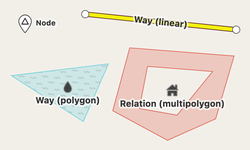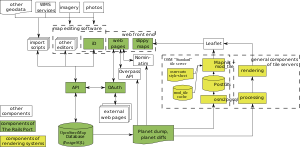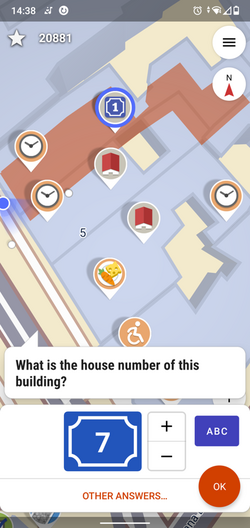OpenStreetMap
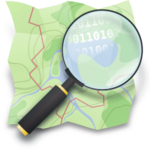 | |
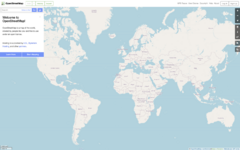 OpenStreetMap homepage, showing the world map | |
| Available in | 96 languages and variants,[1] local languages for map data |
|---|---|
| Country of origin | United Kingdom |
| Owner | OpenStreetMap Foundation |
| Created by | Steve Coast |
| Products | Editable geographic data, tiled web map layer |
| Website | www |
| Commercial | No |
| Registration | Required for contributors, not required for viewing |
| Users | 10.6 million[2] |
| Launched | 9 August 2004 [3] |
| Current status | Active |
Content license | Open Database License |
OpenStreetMap (OSM) is a free, open geographic database updated and maintained by a community of volunteers via open collaboration. Contributors collect data from surveys, trace from aerial imagery and also import from other freely licensed geodata sources. OpenStreetMap is freely licensed under the Open Database License and as a result commonly used to make electronic maps, inform turn-by-turn navigation, assist in humanitarian aid and data visualisation. OpenStreetMap uses its own topology to store geographical features which can then be exported into other GIS file formats. The OpenStreetMap website itself is an online map, geodata search engine and editor.
OpenStreetMap was created by Steve Coast in response to the Ordnance Survey, the United Kingdom's national mapping agency, failing to release its data to the public under free licences in 2004. Initially, maps were created only via GPS traces, but it was quickly populated by importing public domain geographical data such as the U.S. TIGER and by tracing permitted aerial photography or satellite imagery. OpenStreetMap's adoption was accelerated by Google Maps's introduction of pricing in 2012 and the development of supporting software and applications.
The database is hosted by the OpenStreetMap Foundation, a non-profit organisation registered in England and Wales and is funded mostly via donations. Meta (formerly Facebook) launched its distribution called Daylight, based on OSM in 2020. The Linux Foundation's Overture Maps Foundation released their first open map data based on OSM and other sources in July 2023.
History
Steve Coast founded the project in 2004 while at a university in Britain, initially focusing on mapping the United Kingdom.[3] In the UK and elsewhere, government-run and tax-funded projects like the Ordnance Survey created massive datasets but declined to freely and widely distribute them. The first contribution was made in London in 2005.[4][non-primary source needed] In April 2006, the OpenStreetMap Foundation was established to encourage the growth, development and distribution of free geospatial data and provide geospatial data for anybody to use and share.
In April 2007, Automotive Navigation Data (AND) donated a complete road data set for the Netherlands and trunk road data for India and China to the project.[5] By July 2007, when the first "The State of the Map"(SotM) conference[6] was held, there were 9,000 registered users. In October 2007, OpenStreetMap completed the import of a US Census TIGER road dataset.[7] In December 2007, Oxford University became the first major organisation to use OpenStreetMap data on their main website.[8] Ways to import and export data have continued to grow – by 2008, the project developed tools to export OpenStreetMap data to power portable GPS units, replacing their existing proprietary and out-of-date maps.[9] In March 2008, two founders of CloudMade, a commercial company that uses OpenStreetMap data, announced that they had received venture capital funding of €2.4 million.[10]
Yahoo! (2006–2011),[11][12] Bing (2010 – till date),[13] and DigitalGlobe (2017 – till date) [14] allowed their aerial photography, satellite imagery to be used as a backdrop for map production. For a period from 2009 to 2011, NearMap Pty Ltd made their high-resolution PhotoMaps (of major Australian cities, plus some rural Australian areas) available under a CC BY-SA licence.[15]
In 2012, the launch of pricing for Google Maps led several prominent websites to switch from their service to OpenStreetMap and other competitors.[16] Chief among these were Foursquare and Craigslist, which adopted OpenStreetMap, and Apple, which ended a contract with Google and launched a self-built mapping platform using TomTom and OpenStreetMap data.[17]
In March 2020, Facebook announced the initial release of "Daylight Map Distribution", a quality checked snapshot of OpenStreetMap [18] In mid-December 2022, the Linux Foundation announced the launch of a new mapping collaboration, the Overture Maps Foundation.[19] Its stated mission is "powering current and next-generation map products by creating reliable, easy-to-use, and interoperable open map data." Overture founding members were Amazon Web Services (AWS), Meta, Microsoft and TomTom.[20][21][22] Overture is to be complementary to OpenStreetMap, and Overture encourages members to contribute data directly to OpenStreetMap.[23] Overture released alpha dataset consisting of Places of Interest (POIs), Buildings, Transportation Network and Administrative Boundaries layers sourced on 26 July 2023. 59 million worldwide place data support navigation, local search and other applications.[24]
OSM Data
Data structure
OpenStreetMap uses a topological data structure, with four core elements (also known as data primitives):
- Nodes are points with a geographic position, stored as coordinates (pairs of a latitude and a longitude) according to WGS 84. Outside of their usage in ways, they are used to represent map features without a size, such as points of interest or mountain peaks.[25]
- Ways are ordered lists of nodes, representing a polyline, or possibly a polygon if they form a closed loop. They are used both for representing linear features such as streets and rivers, and areas, like forests, parks, parking areas and lakes.[25]
- Relations are ordered lists of nodes, ways and relations (together called "members"), where each member can optionally have a "role" (a string). Relations are used for representing the relationship of existing nodes and ways. Examples include turn restrictions on roads, routes that span several existing ways (for instance, a long-distance motorway), and areas with holes.[25]
- Tags are key-value pairs (both arbitrary strings). They are used to store metadata about the map objects (such as their type, their name and their physical properties). Tags are not freestanding, but are always attached to an object: to a node, a way or a relation.[25] A recommended ontology of map features (the meaning of tags) is maintained on a wiki. New tagging schemes can always be proposed by a popular vote of a written proposal in OpenStreetMap wiki, however, there is no requirement to follow this process. There are over 89 million different kinds of tags in use as of June 2017.[26]
The OpenStreetMap data primitives are stored and processed in different formats. OpenStreetMap server uses PostgreSQL database, with one table for each data primitive, with individual objects stored as rows.[27][28] From this, several database dumps are created, which are available for download. The complete dump is called planet.osm. These dumps exist in two formats, one using XML and one using the Protocol Buffer Binary Format (PBF).[citation needed]
License
OpenStreetMap data and derived tiles were originally published under the Creative Commons Attribution-ShareAlike licence (CC BY-SA) with the intention of promoting free use and redistribution of the data. In September 2012, the licence was changed to the Open Database Licence (ODbL) published by Open Data Commons (ODC) in order to more specifically define its bearing on data rather than representation.[29][30] As part of this relicensing process, some of the map data was removed from the public distribution. This included all data contributed by members that did not agree to the new licensing terms, as well as all subsequent edits to those affected objects. It also included any data contributed based on input data that was not compatible with the new terms. Estimates suggested that over 97% of data would be retained globally, but certain regions would be affected more than others, such as in Australia where 24 to 84% of objects would be retained, depending on the type of object.[31] Ultimately, more than 99% of the data was retained, with Australia and Poland being the countries most severely affected by the change.[32]
All data added to the project needs to have a licence compatible with the Open Database Licence. This can include out-of-copyright information, public domain or other licences. Software used in the production and presentation of OpenStreetMap data may have separate licensing terms.
Map tiles provided by the OpenStreetMap project were licensed under CC-BY-SA-2.0 until 1 August 2020. The ODbL license requires attribution to be attached to maps produced from OpenStreetMap data, but does not require that any particular license be applied to those maps. "©OpenStreetMap Contributors" with link to ODbL copyright page as attribution requirement is used on the site.[33]
Map making
Data sources
Map data is collected by ground survey, personal knowledge, digitizing from imagery, and government data. Ground survey data is collected by volunteers traditionally using tools such as a handheld GPS unit, a notebook, digital camera and voice recorder. Software applications on smartphones (mobile devices) have made it easy for anybody to survey. The data is then entered into the OpenStreetMap database using a number of software tools including JOSM and Merkaator. Mapathon competition events are also held by local OpenStreetMap teams and by non-profit organisations and local governments to map a particular area.
The availability of aerial photography and other data from commercial and government sources has added important sources of data for manual editing and automated imports. Special processes are in place to handle automated imports and avoid legal and technical problems.
Surveys and personal knowledge

Ground surveys are performed by a mapper, on foot, bicycle, or in a car, motorcycle, or boat. Map data was typically recorded on a GPS unit or on a smart phone with mapping app. Once the data has been collected, it is entered into the database by uploading it onto the project's website together with appropriate attribute data. As collecting and uploading data may be separated from editing objects, contribution to the project is possible without using a GPS unit, e.g. by using Paper mapping.
Similar to users contributing data using GPS unit, corporations (e.g. Amazon) with large vehicle fleets use telemetry data from the vehicles to contribute data to OpenStreetMap.[34]
Some committed contributors adopt the task of mapping whole towns and cities, or organising mapping parties to gather the support of others to complete a map area. A large number of less active users contribute corrections and small additions to the map.[citation needed]
Satellite/Aerial images
Maxar,[14] Bing,[13] ESRI, and Mapbox are some of the providers of aerial/satellite imagery which are used as a backdrop for map production.
Street-level image data
Data from several street-level image platforms are available as map data photo overlays. Bing Streetside 360° image tracks, and the open and crowdsourced Mapillary and KartaView platforms provide generally smartphone and windshield-mounted camera images. Additionally, a Mapillary traffic sign data layer, a product of user-submitted images is also available.[35]
Government data
Some government agencies have released official data on appropriate licences. This includes the United States, where works of the federal government are placed under public domain. In the United States, most roads originate from TIGER from the Census Bureau.[36] Geographic names were initially sourced from Geographic Names Information System, and some areas contain water features from the National Hydrography Dataset. In the UK, some Ordnance Survey OpenData is imported. In Canada Natural Resources Canada's CanVec vector data and GeoBase provide landcover and streets.[citation needed]
Globally, OpenStreetMap initially used the prototype global shoreline from NOAA. Due to it being oversimplified and crude, it has been mainly replaced by other government sources or manual tracing.[citation needed]
Out-of-copyright maps can be good sources of information about features that do not change frequently. Copyright periods vary, but in the UK Crown copyright expires after 50 years and hence old Ordnance Survey maps can legally be used. A complete set of UK 1 inch/mile maps from the late 1940s and early 1950s has been collected, scanned, and is available online as a resource for contributors.[37]
Contributors
The project has a geographically diverse user-base, due to emphasis of local knowledge and "on-the-ground" situation in the process of data collection.[38] Many early contributors were cyclists who survey with and for bicyclists, charting cycleroutes and navigable trails.[39] Others are GIS professionals who contribute data with an extension for ArcGIS.[40] Contributors are predominately men, with only 3–5% being women.[41]
By August 2008, shortly after the second The State of the Map conference was held, there were over 50,000 registered contributors; by March 2009, there were 100,000 and by the end of 2009 the figure was nearly 200,000. In April 2012, OpenStreetMap cleared 600,000 registered contributors.[42] On 6 January 2013, OpenStreetMap reached one million registered users.[43] Around 30% of users have contributed at least one point to the OpenStreetMap database.[44][45]
As per a study conducted in 2011, only 38% of members carried out at least one edit and only 5% of members created more than 1000 nodes. Most members are in Europe (72%).[46] According to another study, when a competing maps platform is launched, OSM attracts fewer new contributors and pre-existing contributors increase their level of contribution possibly driven by their ideological attachment to the platform. Overall, there is a negative effect on the quantum of contributions.[47]
Commercial contributors
Some companies freely license satellite/aerial/street imagery sources from which OpenStreetMap contributors trace roads and features, while other companies make data available for importing map data. Automotive Navigation Data (AND) provided a complete road data set for Netherlands and trunk roads data for China and India. In June 2018, the Microsoft Bing team announced contribution of 125 million U.S. building footprints to the project – four times the number contributed by users and government data imports.[48] Amazon uses OpenStreetMap for navigation and has a team which revises the map based on GPS traces and feedback from its drivers.[49] As of February 2021, Apple was the most prolific corporate editor, responsible for 80% of edits to existing roads.[49]
According to a study, nearly 17% of all edits to the map came from corporate teams during 2019–2020. The top 13 corporate contributors during 2014–2020 include Apple, Kaart, Amazon, Facebook, Mapbox, Digital Egypt, Grab, Microsoft, Telenav, Developmentseed, Uber, Lightcyphers and Lyft.[49] There was some vandalism on some occasions attributed to corporate editors.[50][51]
Non-governmental organisations
Humanitarian OpenStreetMap Team (HOT) is a nonprofit organisation promoting community mapping across the world. It developed the open source HOT Tasking Manager for collaboration, and contributed to mapping efforts after the April 2015 Nepal earthquake, the 2016 Kumamoto earthquakes, and the 2016 Ecuador earthquake. The Missing Maps Project, founded by the American Red Cross, Doctors Without Borders, and other NGOs, uses HOT Tasking Manager. The University of Heidelberg hosts the Disastermappers Project for training university students in mapping for humanitarian purposes. When Ebola broke out in 2014, the volunteers mapped 100,000 buildings and hundreds of miles of roads in Guinea in just five days.[52]
Software
OpenStreetMap applications utilize multiple components to provide services. The map data is rendered using pre-generated tiles for various levels of zoom. Editing applications typically support display of imagery, and field mapping data in the form of GPS traces and voice, photo, video annotations to aid in editing map. JOSM, ID, StreetComplete, Rapid, Potlatch are the top 5 editing tools for contributions during 2018–2023 according to a study by Heigit.[53]
OSM Website with integrated iD editor
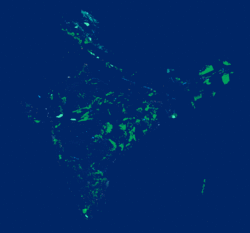
The web site provides a slippy map interface based on the Leaflet JavaScript library (and formerly built on OpenLayers), displaying map tiles rendered by the Mapnik rendering engine[54] The basic map views offered are Standard, Cycle map, Transport map and Humanitarian. In February 2015, OpenStreetMap added route planning functionality to the map on its official website.[55][56]
iD[57] is used for editing on OSM website. It was originally developed by Mapbox, with initial financing from the Knight Foundation and is available under open source.[58] It uses "Ruby on Rails" to enable users to edit maps and view changelogs. The application interfaces with OSM PostgreSQL database for storage of user data and edit metadata. The default map is rendered by Mapnik, stored in PostGIS, and powered by an Apache module called mod_tile. The map data can be edited utilising the satellite/aerial imagery, GPS traces, and local knowledge.
Nominatim[59] (from the Latin, 'by name') is a tool to search OpenStreetMap data by name and address (geocoding) and then to generate synthetic addresses of OpenStreetMap points (reverse geocoding). Data from Nominatim and GeoNames are used for the search functionality in OSM website.[60]
Other desktop/web based applications
"RapiD" is a web based editor derived from iD. It is developed and used by Facebook for "map with ai" project to add artificial intelligence (AI) detected maps of roads to OSM.[61] JOSM, Potlatch,[62] and Merkaartor[63] are more powerful desktop editing applications that are better suited for advanced users.
Mobile applications
Vespucci[64] is the primary full-featured editor for Android; it has been regularly released since 2009. StreetComplete, an Android app launched in 2016,[65] allows users without any OpenStreetMap knowledge to answer simple questions for existing data in OpenStreetMap, and thus contribute data.
Quality
As OSM is a crowd sourced project with complex tagging scheme, there is potential for introduction of unintentional errors and intentional errors. Contributors use history menu on the OSM website, tools like OSMcha, OSM Inspector and Osmose to monitor, review and fix errors.
OpenStreetMap data has been favourably compared with proprietary datasources,[66] although (As of 2009) data quality varied across the world.[67][68] A study in 2011 compared OSM data with TomTom for Germany. For car navigation TomTom has 9% more information, while for the entire street network, OSM has 27% more information.[69]
Mobile applications for general usage
OsmAnd, Locus Map, Maps.me, and Organic Maps are some of the mobile applications for general public use. Some of these also support editing OSM.
OSM community
Humanitarian aid

The 2010 Haiti earthquake established a model for non-governmental organisations (NGOs) to collaborate with international organisations. OpenStreetMap and Crisis Commons volunteers used available satellite imagery to map the roads, buildings and refugee camps of Port-au-Prince in just two days, building "the most complete digital map of Haiti's roads".[71][72] The resulting data and maps have been used by several organisations providing relief aid, such as the World Bank, the European Commission Joint Research Centre, the Office for the Coordination of Humanitarian Affairs, UNOSAT and others.[73]
After Haiti, the OpenStreetMap community continued mapping to support humanitarian organisations for various crises and disasters. After the Northern Mali conflict (January 2013), Typhoon Haiyan[74][75] in the Philippines (November 2013), and the Ebola virus epidemic in West Africa (March 2014), the OpenStreetMap community in association with the NGO Humanitarian OpenStreetMap Team (HOT) has shown it can play a significant role in supporting humanitarian organisations.[52]
Derivative map projects
Several open collaborative mapping projects integrate with the OpenStreetMap database or are otherwise affiliated with the OpenStreetMap project:
- OpenHistoricalMap is a world historical map based on the OpenStreetMap software platform.[76]
- OpenRailwayMap is a detailed online map of the world's railway infrastructure, built on OpenStreetMap data. It has been available since mid-2013 at openrailwaymap.org.[77]
- OpenSeaMap is a world nautical chart built as a mashup of OpenStreetMap, crowdsourced water depth tracks, and third-party weather and bathymetric data.
- Wheelmap.org is a portal for mapping, browsing, and reviewing wheelchair-accessible places.
OSM based companies
Mapbox is one of the earliest company to provide OSM based services. Custom maps can also be generated from OpenStreetMap data through various software including Jawg Maps, Mapnik, Mapbox Studio, Mapzen's Tangrams.[78] OSRM, GraphHopper, MapQuest and Mapbox's Valhalla are some of the route planning application providers.
"State of the Map" conferences
Since 2007, the OpenStreetMap community has held an annual, international conference called State of the Map (SotM) where all stake holders gather to share progress and discuss issues.[6] There are also various national, regional and continental SotM conferences, such as SotM U.S., SotM Baltics, SotM Asia & SotM Africa.
Organisations using OSM
Wikimedia projects provide locator map for cities and travel points of interest based on OpenStreetMap data. Wikipedia uses OpenStreetMap data to render custom maps using Kartographer extension.[79]
A variety of popular services incorporate some sort of geolocation or map-based component. Notable services using OpenStreetMap for this include Facebook,[80] Apple Inc., Craigslist,[81] Flickr,[82] Foursquare,[83] Snapchat,[84] and Strava.[85]
Navigation users include Amazon, Tesla,[86] Garmin, Moovit (public transit navigation),[87] Organic Maps,[88] Geotab,[89] Komoot (Hiking and Cycling guide),[90] and Gurtam.[91]
Game developer users include Ballardia (World of the Living Dead: Resurrection),[92] Niantic (Ingress, Pokémon Go),[93][94] and Hasbro (Monopoly City Streets).[95][96]
Some innovative applications include Webots creating a virtual environment for autonomous vehicle simulations[97] and OpenTopoMap rendering topographic maps based on OpenStreetMap data and on SRTM data.[98]
OSM based research
OpenStreetMap data was used in scientific studies. For example, road data was used for research of remaining roadless areas[99] and in the creation of the annual Forest Landscape Integrity Index.[100]
See also
- Collaborative mapping
- Neogeography
- Turn-by-turn navigation
- Volunteered geographic information
- Google Map Maker
- Waze
- Komoot
References
- ↑ "openstreetmap-website/config/locales at master". https://github.com/openstreetmap/openstreetmap-website/tree/master/config/locales.
- ↑ "OpenStreetMap Statistics". OpenStreetMap Foundation. https://www.openstreetmap.org/stats/data_stats.html.
- ↑ Jump up to: 3.0 3.1 Foody 2017, p. 38.
- ↑ Coast, Steve. "Changeset #1 on OpenStreetMap". https://www.openstreetmap.org/changeset/1.
- ↑ Coast, Steve (4 July 2007). "AND donate entire Netherlands to OpenStreetMap". OpenGeoData. http://old.opengeodata.org/2007/07/04/and-donate-entire-netherlands-to-openstreetmap/index.html.
- ↑ Jump up to: 6.0 6.1 "State of the Map". https://stateofthemap.org/.
- ↑ Willis, Nathan (11 October 2007). "OpenStreetMap project imports US government maps". Linux.com. http://www.linux.com/archive/feature/119493.
- ↑ Batty, Peter (3 December 2007). "Oxford University using OpenStreetMap data". Geothought. http://geothought.blogspot.com/2007/12/oxford-university-using-openstreetmap.html.
- ↑ Fairhurst, Richard (13 January 2008). "Cycle map on your GPS". Système D. http://www.systemed.net/blog/legacy/entry080113140415.html.
- ↑ "Open-source mapping company CloudMade raises €2.4 million in Series A financing round from Sunstone Capital" (PDF) (Press release). 17 March 2008. Archived from the original (PDF) on 13 January 2012. Retrieved 16 September 2022.
- ↑ Coast, Steve (4 December 2006). "Yahoo! aerial imagery in OSM". OpenGeoData. http://old.opengeodata.org/2006/12/04/yahoo-aerial-imagery-in-osm/index.html.
- ↑ Mata, Raj (13 June 2011). "Yahoo! Maps APIs Service Closure Announcement – New Maps Offerings Coming Soon!". Yahoo! Developer Network. http://developer.yahoo.com/blogs/ydn/posts/2011/06/yahoo-maps-apis-service-closure-announcement-new-maps-offerings-coming-soon/.
- ↑ Jump up to: 13.0 13.1 "Bing engages open maps community". 23 November 2010. http://blogs.bing.com/maps/2010/11/23/bing-engages-open-maps-community.
- ↑ Jump up to: 14.0 14.1 "DigitalGlobe satellite imagery launch for OpenStreetMap". https://blog.maxar.com/earth-intelligence/2017/digitalglobe-satellite-imagery-launch-for-openstreetmap.
- ↑ "Community licence". NearMap. http://www.nearmap.com/products/community-licence.
- ↑ Fossum, Mike (20 March 2012). "Websites Bypassing Google Maps Due to Fees". http://www.webpronews.com/websites-bypassing-google-maps-due-to-new-fees-2012-03.
- ↑ Ingraham, Nathan (11 June 2012). "Apple using TomTom and OpenStreetMap data in iOS 6 Maps app". https://www.theverge.com/2012/6/11/3078987/apple-tomtom-openstreemap-ios-6-maps-app.
- ↑ "Announcing Daylight Map Distribution". 10 March 2020. https://daylightmap.org/2020/03/10/announcing-daylight-map-distribution.html.
- ↑ "Overture Maps Foundation – Linux Foundation Project" (in en-US). https://overturemaps.org/.
- ↑ Sawers, Paul (2022-12-15). "Meta, Microsoft, AWS and TomTom launch the Overture Maps Foundation to develop interoperable open map data" (in en-US). https://www.msn.com/en-us/news/technology/meta-microsoft-aws-and-tomtom-launch-the-overture-maps-foundation-to-develop-interoperable-open-map-data/ar-AA15iVuh.
- ↑ Plumb, Taryn (2022-12-15). "Creating the ultimate smart map with new map data initiative launched by Linux Foundation" (in en-US). https://venturebeat.com/virtual/creating-the-ultimate-smart-map-with-new-map-data-initiative-launched-by-linux-foundation/.
- ↑ "Linux Foundation Announces Overture Maps Foundation to Build Interoperable Open Map Data" (in en-US). 15 December 2022. https://finance.yahoo.com/news/linux-foundation-announces-overture-maps-110000418.html.
- ↑ "FAQ – Overture Maps Foundation" (in en-US). https://overturemaps.org/resources/faq/.
- ↑ Bar, Kyle (2023-07-26). "Linux Group Shares Its First Open Dataset for Creating Real Google Maps Alternatives". https://gizmodo.com/google-maps-alternative-overture-maps-data-linux-1850675768.
- ↑ Jump up to: 25.0 25.1 25.2 25.3 Foody 2017, p. 39.
- ↑ Mocnik, Franz-Benjamin; Zipf, Alexander; Raifer, Martin (18 September 2017). "The OpenStreetMap folksonomy and its evolution". Geo-spatial Information Science 20 (3): 219–230. doi:10.1080/10095020.2017.1368193. Bibcode: 2017GSIS...20..219M.
- ↑ "OpenStreetMap Wiki: Database". https://wiki.openstreetmap.org/wiki/Database.
- ↑ "Databases and data access APIs". https://wiki.openstreetmap.org/wiki/Databases_and_data_access_APIs.
- ↑ Fairhurst, Richard (7 January 2008). "The licence: where we are, where we're going". OpenGeoData. http://old.opengeodata.org/2008/01/07/the-licence-where-we-are-where-were-going/index.html.
- ↑ "Licence – OpenStreetMap Foundation". https://wiki.osmfoundation.org/wiki/Licence.
- ↑ Poole, Simon. "OSM V1 Objects ODbL acceptance statistics". http://odbl.poole.ch.
- ↑ Wood, Harry (26 July 2012). "Automated redactions complete". http://blog.osmfoundation.org/2012/07/26/automated-redactions-complete/.
- ↑ "New licence for the "standard style" tiles from openstreetmap.org". 2020-06-25. https://blog.openstreetmap.org/2020/06/25/new-licence-for-the-standard-style-tiles-from-openstreetmap-org/.
- ↑ Sarkar, Dipto; Anderson, Jennings T. (June 2022). "Corporate editors in OpenStreetMap: Investigating co‐editing patterns". Transactions in GIS 26 (4): 1879–1897. doi:10.1111/tgis.12910.
- ↑ Mahabir, Ron; Schuchard, Ross; Crooks, Andrew; Croitoru, Arie; Stefanidis, Anthony (26 May 2020). "Crowdsourcing Street View Imagery: A Comparison of Mapillary and OpenStreetCam". ISPRS International Journal of Geo-Information 9 (6): 341. doi:10.3390/ijgi9060341. Bibcode: 2020IJGI....9..341M.
- ↑ "2.2 Exploring TIGER and OSM Data". Penn State College. https://www.e-education.psu.edu/geog855/node/798.>
- ↑ "Ordnance Survey". https://maps.nls.uk/os/.
- ↑ How we map, wiki.openstreetmap.org, retrieved 1 August 2021.
- ↑ "Key and More Info". OpenCycleMap. http://www.opencyclemap.org/docs/.
- ↑ Vines, Emily. "Esri Releases ArcGIS Editor for OpenStreetMap". Esri. http://www.esri.com/news/releases/10_3qtr/openstreetmap.html.
- ↑ "Gender and Experience-Related Motivators for Contributing to OpenStreetMap". https://publik.tuwien.ac.at/files/PubDat_218905.pdf
- ↑ "Stats". OpenStreetMap Wiki. https://wiki.openstreetmap.org/wiki/Stats.
- ↑ Wood, Harry (6 January 2013). "1 million OpenStreetMappers". OpenGeoData. http://opengeodata.org/1-million-openstreetmappers.
- ↑ Neis, Pascal. "The OpenStreetMap Contributors Map aka Who's around me?". http://neis-one.org/2013/01/oooc/.
- ↑ "OSMstats - Statistics of the free wiki world map". https://osmstats.neis-one.org/?item=members.
- ↑ Neis, Pascal; Zipf, Alexander (2012). "Analyzing the Contributor Activity of a Volunteered Geographic Information Project — The Case of OpenStreetMap". ISPRS International Journal of Geo-Information 1 (2): 146–165. doi:10.3390/ijgi1020146. Bibcode: 2012IJGI....1..146N.
- ↑ Nagaraj, Abhishek; Piezunka, Henning (2020). "How Competition Affects Contributions to Open Source Platforms: Evidence from OpenStreetMap and Google Maps". https://static1.squarespace.com/static/6232322165ae714579213636/t/6359a999dc3cc409cb2d5941/1666820507503/how-competition-affects-contributions-to-open-source-platforms.pdf.
- ↑ "Microsoft releases more than 100 million Building Footprints in the US as open data". Geospatial World. 3 July 2018. https://www.geospatialworld.net/blogs/microsoft-releases-building-footprints/.
- ↑ Jump up to: 49.0 49.1 49.2 Dickinson, Corey (19 February 2021). "OpenStreetMap Charts a Controversial New Direction: Inside the 'Wikipedia of Maps,' Tensions Grow Over Corporate Influence". Bloomberg. https://www.bloomberg.com/news/articles/2021-02-19/openstreetmap-charts-a-controversial-new-direction.
- ↑ "آیا مسیریاب بلد بهطور عامدانه و سیستماتیک در نقشههای OSM خرابکاری میکند؟ (بروزرسانی)" (in fa). 2021-07-05. https://www.zoomit.ir/tech-iran/372281-balad-open-street-map-saudi-arabia-sabotage/.
- ↑ "Google Blames Rogue Contractors For OpenStreetMap Sabotage" (in en-US). 2012-01-18. https://www.slashgear.com/google-blames-rogue-contractors-for-openstreetmap-sabotage-18209666/.
- ↑ Jump up to: 52.0 52.1 Foody 2017, p. 43.
- ↑ "Exploring OSM editor statistics by combining data from OSHDB and changeset DB". 1 August 2023. https://heigit.org/exploring-osm-editor-statistics-by-combining-data-from-oshdb-and-changeset-db/.
- ↑ "OpenCycleMap.org – the OpenStreetMap Cycle Map". http://opencyclemap.org.
- ↑ Filney, Klint (11 November 2013). "Out in the Open: How to Get Google Maps Directions Without Google". Wired. https://www.wired.com/wiredenterprise/2013/11/osrm.
- ↑ "Routing on OpenStreetMap.org | OpenStreetMap Blog". https://blog.openstreetmap.org/2015/02/16/routing-on-openstreetmap-org/.
- ↑ Franzen, Carl (2013-05-07). "Can new OpenStreetMap editor use the crowd to beat Google Maps?". https://www.theverge.com/2013/5/7/4306500/openstreetmap-id-editor-from-mapbox-launches.
- ↑ Barth, Alex (20 May 2013). "Collaborating to improve OpenStreetMap infrastructure". https://knightfoundation.org/articles/collaborating-improve-openstreetmap-infrastructure.
- ↑ "Nominatim website homepage". Nominatim. https://nominatim.org.
- ↑ "GeoNames". https://www.geonames.org/.
- ↑ "mapwith.ai". https://mapwith.ai/.
- ↑ Fairhurst, Richard (8 June 2022), Potlatch, https://github.com/systemed/potlatch3, retrieved 13 August 2022
- ↑ "merkaartor.be". http://merkaartor.be/.
- ↑ "Vespucci". https://vespucci.io/.
- ↑ Zwick, Tobias (21 February 2018). "StreetComplete: Surveyor app for Android". https://github.com/westnordost/StreetComplete.
- ↑ Zielstra, Dennis. "Comparing Shortest Paths Lengths of Free and Proprietary Data for Effective Pedestrian Routing in Street Networks". University of Florida, Geomatics Program. http://flrec.ifas.ufl.edu/hochmair/pubs/TRR_zielstra_hochmair_2012_finaldraft.pdf.
- ↑ Haklay, M. (2010). "How good is volunteered geographical information? A comparative study of OpenStreetMap and Ordnance Survey datasets.". Environment and Planning B: Planning and Design 37 (4): 682–703. doi:10.1068/b35097. https://kfrichter.org/crowdsourcing-material/day1/haklay10.pdf. Retrieved 7 July 2017.
- ↑ Coleman, D. (2013). "Potential Contributions and Challenges of VGI for Conventional Topographic Base-Mapping Programs". in Sui, D.. Crowdsourcing Geographic Knowledge: Volunteered Geographic Information (VGI) in Theory and Practice. New York, London: Springer Science+Business Media Dordrecht. pp. 245–264. doi:10.1007/978-94-007-4587-2. ISBN 978-94-007-4586-5.
- ↑ Neis, Pascal; Zielstra, Dennis; Zipf, Alexander (2011). "The Street Network Evolution of Crowdsourced Maps: OpenStreetMap in Germany 2007–2011". Future Internet 4: 1–21. doi:10.3390/fi4010001.
- ↑ "OpenStreetMap Activities for Typhoon Haiyan (2013)". http://resultmaps.neis-one.org/osm-typhoon-haiyan-2013-contributors.
- ↑ Forrest, Brady (1 February 2010). "Technology Saves Lives In Haiti". Forbes .com. https://www.forbes.com/2010/02/01/text-messages-maps-technology-breakthroughs-haiti.html.
- ↑ "Digital Help for Haiti". The New York Times. 27 January 2010. http://gadgetwise.blogs.nytimes.com/2010/01/27/digital-help-for-haiti/.
- ↑ European Commission Joint Research Centre (15 January 2010). "Haiti Earthquakes: Infrastructure Port-au-Prince 15/01/2010". http://ec.europa.eu/dgs/jrc/downloads/jrc_pp_haiti_map_04.pdf.
- ↑ MacKenzie, Debora (12 November 2013). "Social media helps aid efforts after typhoon Haiyan". https://www.newscientist.com/article/dn24565-social-media-helps-aid-efforts-after-typhoon-haiyan.html#.U-QaA2MmUro.
- ↑ Meyer, Robinson (12 November 2013). "How Online Mapmakers Are Helping the Red Cross Save Lives in the Philippines". https://www.theatlantic.com/technology/archive/2013/11/how-online-mapmakers-are-helping-the-red-cross-save-lives-in-the-philippines/281366/.
- ↑ Travis, Charles; Dixon, Deborah P.; Bergmann, Luke; Legg, Robert; Crampsie, Arlene (12 September 2022). Routledge Handbook of the Digital Environmental Humanities. Taylor & Francis. ISBN 978-1-000-63584-3. https://books.google.com/books?id=DaZ9EAAAQBAJ&dq=OpenHistoricalMap&pg=PT594. Retrieved 19 December 2022.
- ↑ "OpenRailwayMap - OpenStreetMap Wiki". https://wiki.openstreetmap.org/wiki/OpenRailwayMap.
- ↑ "Interactive Maps Can Now Get the 'Matrix' Treatment". 2015-05-13. https://www.bloomberg.com/news/articles/2015-05-12/mapzen-s-tangram-engine-lets-you-make-custom-maps-with-unprecedented-new-design-tools.
- ↑ "Interactive maps, now in your language". 2018-06-28. https://diff.wikimedia.org/2018/06/28/interactive-maps-now-in-your-language/.
- ↑ Adkins, Jonah (25 February 2021). "Launching the Facebook Map". https://hi.stamen.com/launching-the-facebook-map-8d028c4f0e0e.
- ↑ Cooper, Daniel (28 August 2012). "Craigslist quietly switching to OpenStreetMap data". Engadget. https://www.engadget.com/2012/08/28/craigslist-open-street-map/.
- ↑ "Around the world and back again". blog-flickr.net. 12 August 2008. http://blog.flickr.net/en/2008/08/12/around-the-world-and-back-again/.
- ↑ "Foursquare Blog". Blog.foursquare.com. http://blog.foursquare.com/2012/02/29/foursquare-is-joining-the-openstreetmap-movement-say-hi-to-pretty-new-maps/.
- ↑ "Snapchat's new Snap Map shows users their friends' locations". geoawesomeness.com. 22 June 2017. http://geoawesomeness.com/snapchat-buys-zenly-show-users-friends/.
- ↑ Anderson, Elle (28 July 2015). "Feedback for Strava's new maps (OpenStreetMap)". Strava.com. https://support.strava.com/hc/en-us/community/posts/208861297-Feedback-for-Strava-s-new-maps-OpenStreetMap-.
- ↑ "OpenStreetMaps and Smart Summon". 19 October 2019. https://teslamotorsclub.com/tmc/threads/openstreetmaps-and-smart-summon.170675/.
- ↑ "Moovit online trip planner". Moovit.com. http://moovit.co.il/.
- ↑ "Organic Maps website". https://organicmaps.app/.
- ↑ S, Maria (8 October 2013). "Smarter Fleet Management with Geotab's Posted Road Speed Information". Geotab. http://www.geotab.com/blog/smarter-fleet-management-with-geotabs-posted-road-speed-information/.
- ↑ Butcher, Mike (12 August 2013). "Komoot Launches Its Hiking And Cycling Guide App Across European Regions". https://social.techcrunch.com/2013/08/12/komoot-launches-its-hiking-and-cycling-guide-app-across-european-regions/.[yes|permanent dead link|dead link}}]
- ↑ Bravina, Tatsiana (15 February 2021). "Updates: what's new in January 2021". Gurtam. https://gurtam.com/en/blog/updates-whats-new-in-january-2021.
- ↑ "World of the Living Dead Resurrection Expands Closed Beta". StrategyInformer.com. http://www.strategyinformer.com/news/26286/world-of-the-living-dead-resurrection-expands-closed-beta.
- ↑ "Pokemon Go now uses OSM". http://comicbook.com/gaming/2017/12/01/pokemon-go-maps/.
- ↑ Groux, Christopher (1 December 2017). "'Pokémon Go' Map Updated To OSM From Google Maps: What Is OpenStreetMap?". https://www.ibtimes.com/pokemon-go-map-updated-osm-google-maps-what-openstreetmap-2622624.
- ↑ Raphael, JR (8 September 2009). "'Monopoly City Streets' Online Game: Will Buying Park Place Be Any Easier?". PC World. http://www.pcworld.com/article/171610/monopoly_city_streets_online_game_will_buying_park_place_be_any_easier.html.
- ↑ "Monopoly game launches on Google". BBC Online. 9 September 2009. http://news.bbc.co.uk/2/hi/technology/8245700.stm.
- ↑ "Webots OpenStreetMap Importer". https://www.cyberbotics.com/doc/automobile/openstreetmap-importer.
- ↑ "OpenTopoMap". https://wiki.openstreetmap.org/wiki/OpenTopoMap.
- ↑ Ibisch, Pierre L.; Hoffmann, Monika T.; Kreft, Stefan; Pe'Er, Guy; Kati, Vassiliki; Biber-Freudenberger, Lisa; Dellasala, Dominick A.; Vale, Mariana M. et al. (2016). "A global map of roadless areas and their conservation status". Science 354 (6318): 1423–1427. doi:10.1126/science.aaf7166. PMID 27980208. Bibcode: 2016Sci...354.1423I. https://www.researchgate.net/publication/311667612. Retrieved 17 October 2018.
- ↑ Grantham, H. S.; Duncan, A.; Evans, T. D.; Jones, K. R.; Beyer, H. L.; Schuster, R.; Walston, J.; Ray, J. C. et al. (2020). "Anthropogenic modification of forests means only 40% of remaining forests have high ecosystem integrity - Supplementary Material". Nature Communications 11 (1): 5978. doi:10.1038/s41467-020-19493-3. ISSN 2041-1723. PMID 33293507. Bibcode: 2020NatCo..11.5978G.
Bibliography
Foody, Giles (2017). Mapping and the Citizen Sensor. London: Ubiquity Press. ISBN 978-1-911529-16-3. https://www.jstor.org/stable/j.ctv3t5qzc.
Further reading
- Bennett, Jonathan (2010). OpenStreetMap: Be Your Own Cartographer. Packt Publishing. ISBN 978-1-84719-750-4.
- Ramm, Frederik; Topf, Jochen; Chilton, Steve (2010). OpenStreetMap: Using and Enhancing the Free Map of the World. UIT Cambridge. ISBN 978-1-906860-11-0.
External links
- OpenStreetMap wiki
- State of the Map Conference website
- OpenStretMap statistics website by Pascal Neis
 |

